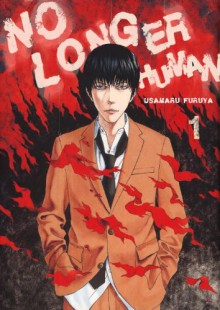
This is technically the first volume of a manga adaptation of Osamu Dazai’s No Longer Human. However, in reality it’s more like a work inspired by Osamu Dazai’s No Longer Human. It has a lot of the same characters and a lot of the same events, but also enough important changes that the impact of certain familiar scenes and characters is completely different. I’m not sure how I feel about that.
The volume begins with Usamaru Furuya as a character in his own manga. He’s trying, and failing, to think up an idea for his next serial when he suddenly gets an anonymous email pointing him to an online “ouch diary.” The website contains three images: one of 6-year-old Yozo posing with his family while wearing a wide fake smile; one of Yozo at age 25, his expression lifeless and worn down; and one of Yozo at age 17, cool and handsome. Furuya proceeds to read the diary that goes with those images, to learn how Yozo fell so far so quickly.
Then readers get the story of Yozo’s life, starting with a few pages showing him as a child and middle school student, behaving like a class clown in order to get people to like him. The story quickly progresses into Yozo’s high school years, when he is befriended by Horiki, who Yozo believes is truly what he has spent his life pretending to be, a friendly and shiftless clown. Although Yozo starts off with everything in life handed to him on a silver platter, things rapidly fall apart, and the volume ends with Yozo’s first suicide attempt (I’m assuming the manga will include the next one).
When I reviewed Osamu Dazai’s No Longer Human, I said that the beginning of the book, which dealt with Yozo’s childhood, worked best for me. Furuya opted to either skip most of that or include it as vague flashbacks. I thought, at first, that I’d be okay with this, until I realized that it really changed the overall tone. In the book, Yozo started off as a child who couldn’t empathize with others, had trouble figuring out what other people were thinking and why they acted the way they acted the way they did, and was terrified that people would see through his desperate attempts to fit in. The manga wasn’t as successful at setting the stage, and so high school Yozo was even more insufferable. Readers basically only saw Yozo at his absolute worst, looking down on everyone around him, drinking, skipping class, and paying for sex and doing his very best to not get to know the women he had sex with as actual people.
A few things I should add, at this point. First, Furuya aged Yozo down a bit. I don’t think Yozo met Horiki until college in the book, whereas in the manga they became friends during high school (with Yozo, the word "friend" can be assumed to mean nothing more than "acquaintance with whom he spends time"). Also, unlike the book, which alluded to sex but never mentioned anything in detail, there is quite a bit of on-page sex in the manga. One scene in particular did a good job of getting across the kind of guy Yozo was: he found himself distracted by thoughts of something a friend from school told him while he was having sex with a girl who’d just told him she wanted him to be her boyfriend. Then he couldn’t understand why she was so upset with him. I don’t know that the other sex scenes (four, total) were strictly necessary, though.
Now, back to the story/character changes. Another thing Furuya did was add a bit more to the plot. In the book, Yozo hung out with Marxists and took part in meaningless (to him) meetings and activities. The work annoyed him, but he stayed with the group because he couldn’t quite figure out how to leave and because others expected him to do things. In the manga, Yozo actually kind of liked being involved with the Japan United Labor Association, although he looked down on its members. He gradually realized that they were
planning terrorist activities, and he might have become even further involved if it hadn’t been for an incident involving a jealous boyfriend.
(spoiler show)
Furuya also ascribed emotions to Yozo that I’m not really sure he actually felt in the original book. For example, in the manga Yozo indicated that he actually cared about Ageha (I can’t remember if that was her name in the novel, too). I don’t know that the Yozo of the original novel truly cared about a single person, especially enough to admit it to himself. He cared about how people made him see himself, and that was pretty much it.
This was a funhouse mirror sort of adaptation, although the end result was still largely “miserable people doing self-destructive things." I’ll read the next volume because I already have it on hand, but I doubt I’ll be putting in an ILL request for the third and final volume.
(Original review posted on A Library Girl's Familiar Diversions.)

 Log in with Facebook
Log in with Facebook 



![The Caterpillar [Imo-Mushi][芋虫] - Suehiro Maruo,Rampo Edogawa The Caterpillar [Imo-Mushi][芋虫] - Suehiro Maruo,Rampo Edogawa](http://booklikes.com/photo/max/220/330/upload/books/9/b/9b0a193b7deedd5994af18596e3680a6.jpg)









